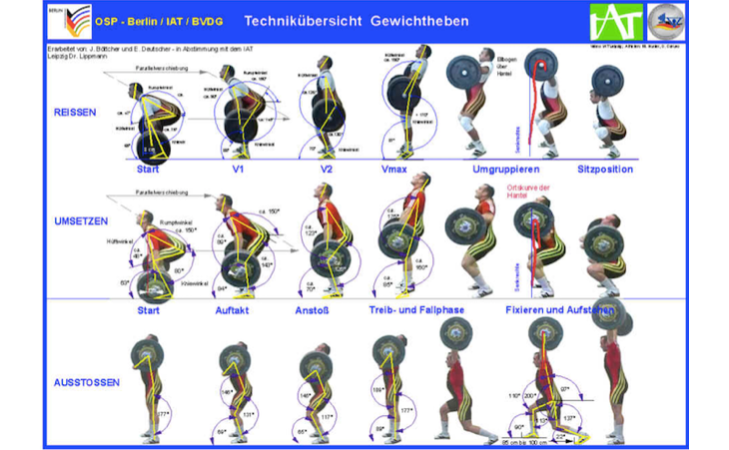As already explained in the article " Weightlifting - The History ", there have only been two exercises since 1972, independent of the weight classes, in which the athletes compete in weightlifting. The snatch and the thrust.
Tear technique description
When snatching, the load is moved in a wide grip ( snatch grip ) from the ground over the head in one go. The snatch is divided into two pull phases and a regrouping phase. The snatch is the more technically challenging weightlifting competition exercise that requires more mobility in all major joints and can use less weight than the clean and jerk.
1. In the starting position, the barbell is a few inches in front of the shins, the arms and back are straight, and there is a parallel shift, which means the weight is lifted off and the back and hip angle remain constant until the barbell is at knee height . (1st move phase)
2. From knee to hip, the barbell is pulled along the thighs, keeping the arms straight and bearing the full foot, opening the knee and hip angles. When the dumbbell is at hip height, the shoulders are pulled up and the ankles are stretched (2nd pull phase). Ideally, the arms remain stretched here as well.
3. After the 2nd pull, the athlete jumps into a crouch and actively pulls on the dumbbell with his arms (regrouping phase)
4. Shortly before the squat, the athlete brakes the dumbbell with straight arms (braking phase). You can stay in this position as long as you like to stabilize the barbell over your head. The arms are fully extended in the final position and the weight must be held motionless in the final position with legs straight and feet parallel until signaled by the referee.
Commonly used snatch training drills are: hang snatch, standing snatch, elevated/buck snatch, and wide pull.
Technique description thrusting
Pushing ( engl. Clean and Jerk ) consists of moving and ejecting
1. The starting position for the clean is similar to that for the snatch, but the barbell is gripped with a tight grip ( clean grip ). Then there is also a parallel shift. The dumbbell is then not pulled up to the hips in the second pull, but the dumbbell is placed briefly in the lower third of the thigh and at the same time there is an explosive stretching of the knee and hip joints, with the dumbbell being a few centimeters away from the thigh.
2. When regrouping, the elbows are rotated quickly forward to brake the barbell like a front squat from half squat to deep squat.
3. There are different techniques for ejecting ( jerk ) (crouch eject, lunge ejection and standing ejection technique). However, all variants have the identical initial movement. Pressure is on full foot, knee flexion 7-10 inches, then explosive knee and hip extension, with shoulder push and ankle extension. The athlete now uses the resulting momentum with which the barbell is moved by stretching his arms as quickly as possible and jumping under the barbell at the same time, in order to then lift them over his head with stretched arms and legs and both feet at the same height balanced and kept motionless until the referee's signal.
Commonly used jerk variations are: clean from an elevated position/bucks, standing clean, standing jerk and tight pull.
Since the snatch and clean and jerk and their variations are very explosive exercises, they are not only used to train weightlifters for their competition, but also by athletes in all kinds of sports that require the development of mobility, explosive power and speed .
If you also want to reap the benefits of Olympic lifts, sign up for the YPSI Weightlifting Workshop here.
For an article on weightlifting systems, click here.
Image: Technical mission statement of the BVDG, which has been hanging in my office in the YPSI since day 1 and can be purchased directly here as a poster.

